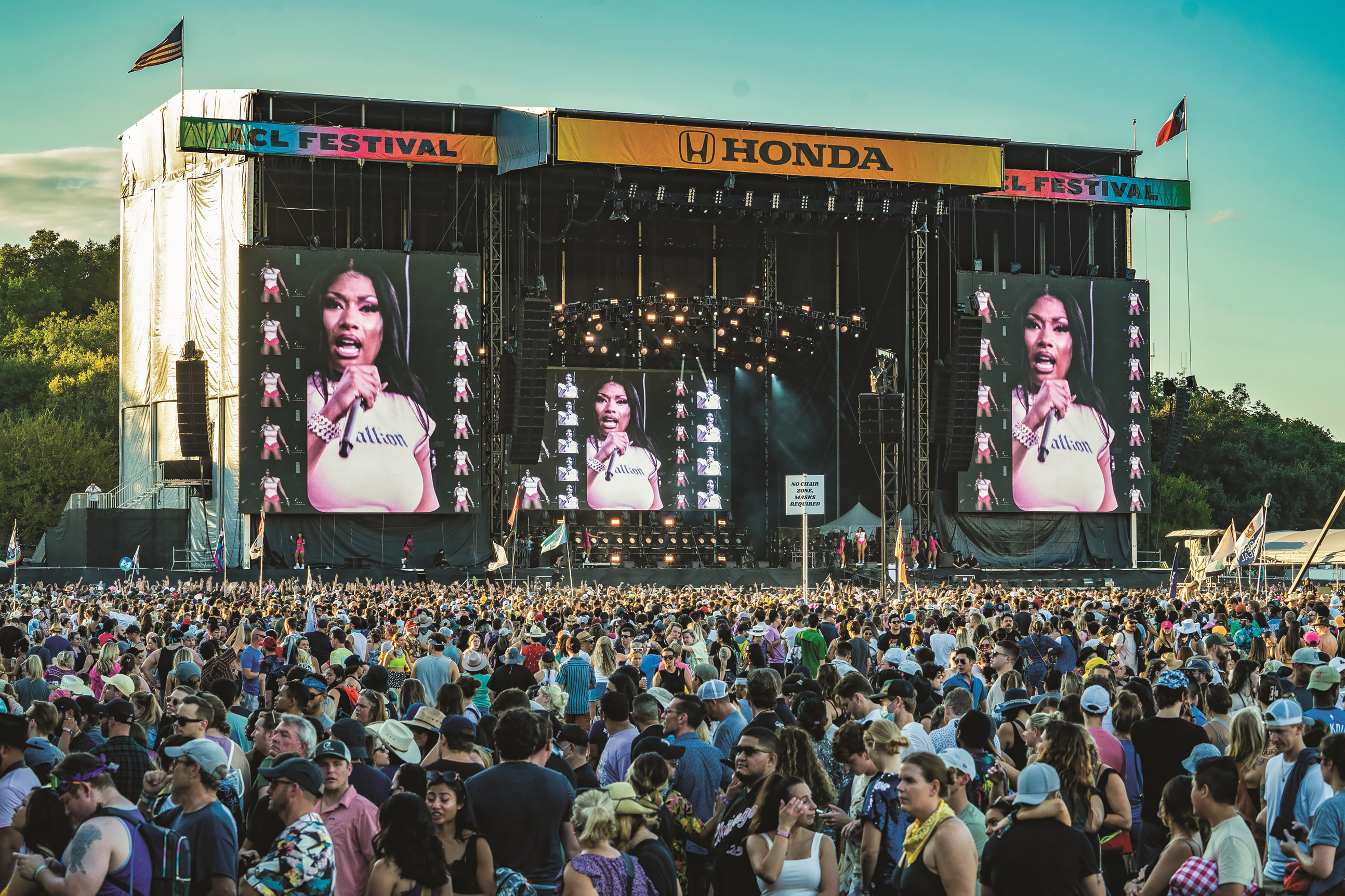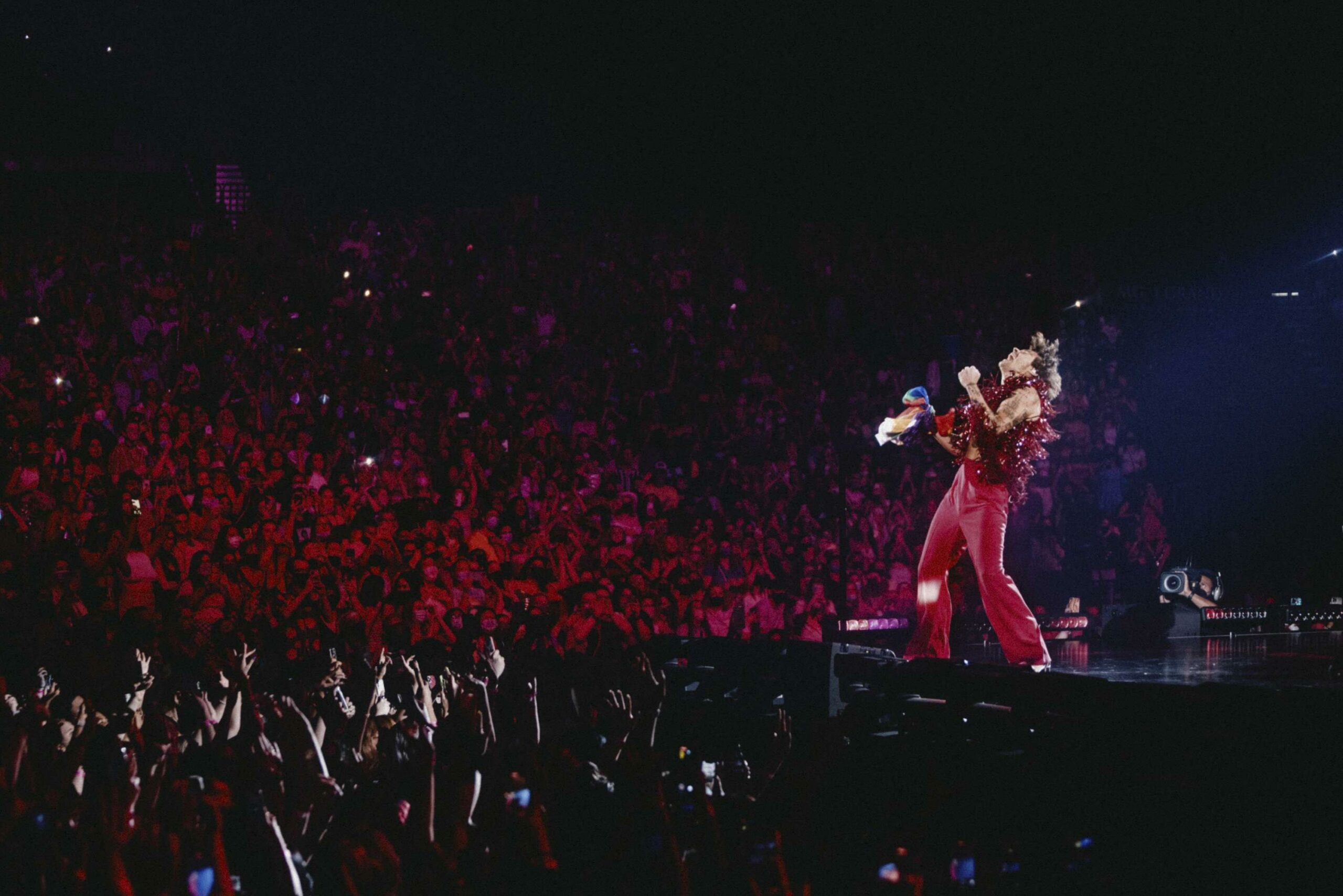
Erika Goldring / WireImage – Do Call It A Comeback.
. Megan Thee Stallion, who already has dates for 2022, performs at Austin City Limits Music Festival at Zilker Park on Oct. 1, 2021, in Austin, Texas. The event brought in more than 75K per day over two consecutive three-day weekends.
What a difference a year makes. By every measure, 2021 was both quantitatively and qualitatively better than 2020, which was catastrophic. Every chart in last year’s Year End issue quantifying touring data from 2018, ’19 and ’20, looked like two skyscrapers beside a shack marking a precipitous drop in shows, revenues, ticket sales and all other touring metrics. This year, however, is markedly different, especially Q4, which augers exceedingly well for 2022.
This year the data seemed to flip it and reverse it, as Missy Elliott might say. What started out promising and took a nosedive in 2020 with the shutdown of live events in March, slowly and steadily built through 2021 with a strong final quarter. If last year’s graph showed a free-fall, this year’s data is a glorious hockey stick that began building in spring, with grosses and tickets going from non-existent to what we can now call “normal” and, in some cases, better than that.

–
When the data from 2021’s top tours is extrapolated, including The Rolling Stones, Harry Styles, The Hella Mega Tour (with Green Day, Fall Out Boy and Weezer), Eagles, Dead & Company, Los Bukis, Guns N’ Roses, Dave Matthews Band, Phish and Jonas Brothers among others – the data is on par with – or better than – the biggest tours of 2018 and 2019. That data portends extremely well for a full-on return and then some in 2022 – which could very well be the biggest touring year on record.
Based on Pollstar’s Q4 data, which represents the vast majority of the 2021’s touring data, we can project that 2022 is going to be a banner year for the live industry. This because Q4 historically represents approximately 24% of the total gross and ticket sales for our Year-End Top 100 Worldwide Tours. From Q4 2021’s $1.34 billion gross and ticket sales of 15.6 million we can extrapolate a total gross of $5.63 billion and ticket sales of nearly 65 million for the Top 100 Tours of 2022. Comparing those numbers against 2019’s record-setting year represents a massive 12% jump in ticket sales and a more modest 1% increase grosses. Looking at the size, scope and volume of the 25,509 shows for 2022 currently in Pollstar’s tour database, including runs by major stadium and arena level acts, as well as an expected increase in ticket pricing and pent-up consumer demand, we can forecast that 2022 will be a record-setting year.
Contributing to that projection is the fact that 2020 was on course to be the most successful year in the history of the live industry. Coming off a record-setting 2019, Pollstar’s first quarter, which ran Nov. 21-Feb. 19, was well in the books before the mid-March collapse and showed an industry reaching glorious new heights. This included a record-setting Q1 Top 100 Worldwide Tours gross, which jumped nearly 11% to $840 million, and ticket sales that grew 4.5% to 9.4 million. Then, in mid-March, everything crashed. Crickets. Painful silence. Uncertainty, fear and trepidation in even just leaving the house let alone going to a show.

–
2021 was that in reverse. The year began dismally and the first quarter, for all intents and purposes, was a continuation of 2020’s crickets. 382 shows reported in Q1 with ticket sales dropping to 397K and gross revenues falling to $18.9 million. It’s soul crushing to recount, but you’ve got to hit bottom before you climb out of a hole.
The live industry’s emergence coincided with the nationwide roll-out of vaccines, which the live industry got behind early. On Jan. 26, a coalition of live event leaders sent a letter to President Joe Biden offering to help with the vaccine effort. Signatories included Live Nation, AEG Presents, International Association of Venue Managers, the National Association of Music Merchants, the National Independent Talent Organization, the National Independent Venue Association, and Oak View Group (Pollstar’s parent company), among others to formally offer venues, staff, and expertise toward the vaccination effort.
By 2021’s mid-year (Nov. 19, 2020-May 19, 2021), Pollstar’s Global Boxoffice totals had increased exponentially with revenues climbing to $75.4 million from 1,522 performances and 1.6 million tickets sold. With that came the growing standardization of health and safety protocols, which often included proof of vaccine, testing and masks, helping to build consumer confidence in the market. With the rise of outdoor shows and sheds, which more than doubled their market share in 2021 helping to lead the way back, the isolation and fear began to recede.
The Foo Fighters’ June 20 indoor gig at Madison Square Garden (see page 53) was one of they year’s major milestones requiring proof of vaccination. “You know this is gonna be a long fucking night because guess what,” Dave Grohl asked in the middle of the “The Pretender.” “We’ve been waiting for this.” It turned out so was everyone else.

–
Do Call It A Comeback: A view of 2021’s Lollapalooza, which safely drew some 400,000 to Grant Park between July 29-Aug. 1 helping establish a proof of concept for health and safety protocols for the industry. (Photo by Gary Miller/FilmMagic)

–
The Rolling Stones, whose “No Filter Tour” had 2021’s highest gross (Photo: J. Bouquet/Courtesy Concerts West)
Perhaps no greater bellwether exited in live for 2021 than Lollapalooza (see page 47), the year’s first major festival back, which some wrongly predicted would be a “super-spreader event.” That fest, promoted by C3 Presents, a subsidiary of Live Nation, helped establish a proof of concept for festival COVID policies requiring fans to be vaccinated or show a negative test within 72 hours before entering. The promoter reported 90% of attendees were fully vaccinated and local health officials said the festival was far from the feared super-spreader event, despite 400,000 total attendees at Grant Park over four days. Perhaps even more gratifying, the Lollapalooza motivated some attendees to get vaccinated.
The biggest testament to 2021’s Great Return, though, are its top two tours: The Rolling Stones “No Filter Tour,” which had the year’s highest gross with 12 stadium shows bringing in $115.5 million; and Harry Styles’ “Love On Tour,” which, for the Pollstar chart year, hit 39 arenas over two-and-a-half months moving 669K tickets, the highest amount of any tour playing an arena on average almost every other night.
A closer look at the Stones’ run, which had two dates outside of Q4 (which ended Nov. 19), brought their total haul to $130.9 million over the course of 14 shows between Sept. 26 and Nov. 23 – in just two months’ time. If the Stones were to continue at that pace for three more quarters, their haul for the year would total $525 Million – significantly more than the pre-pandemic top tours of 2018, when Ed Sheeran his $432 million, and 2019, for which Pink led the chart with $215 million.

–
Harry Styles, whose “Love On Tour” had 2021’s highest ticket sales playing 42 arena shows over the course of three months. (Photo: Anthony Pham/Courtesy Full Stop Mgmt.)
As for Styles, his torrid pace in the calendar year, which ran Sept. 4-Nov. 24, moved 719K tickets at 42 arena shows. If he continued at that clip for a full year, his ticket sales would reach 2.9 million. That’s more than anyone on the pre-pandemic 2019 Top 100 Worldwide Chart and trails only Ed Sheeran and Taylor Swift’s 2018 year-end tally, who played stadiums.
Q4 2021, the year’s biggest quarter (with data still coming in), blew 2020 out of the water and measures up to 2019. The quarter’s 9,625 shows is an over 800% increase over Q4 2020’s 1,109 and nearly 60% of Q4 2019’s 16,581 shows. Q4 2021’s average gross per show, tickets sold per show and ticket price, however, surpassed Q4 2019. Its $221,278 average gross was 38.9% greater than 2019’s $159,262. And while the quarter’s average tickets per show of 2,825 beat 2019’s 2,326 by 21%, its average ticket price of $78.30 was 14.4% greater than 2019’s $68.46 explaining the greater average revenues.
Also well worth noting, and portending well for 2022, is the fact that the vast majority of 2021’s touring data came from the U.S. market. In fact, this year, there is little difference between the Year-End North American and Worldwide charts.. As other territories open, including Europe, Asia, The Middle East and South America, where pent-up demand is likely intense, we can further expect 2022 to be a banner year.
In Live Nation’s Nov. Q3 earnings report CEO and president Michael Rapino provided more encouraging news. “The 2021 summer concerts season rebounded quickly,” he said, “with 17 million fans attending our shows in the quarter, as the return to live reflected tremendous pent-up demand, As we now look forward to 2022, we are encouraged by all our leading indicators across each business. Through October, our confirmed show count across amphitheaters, arenas and stadiums is up double-digits relative to the same time in 2019 for 2020 shows, and through mid-October, we have already sold 22 million tickets for our shows in 2022.”
All of this bodes well for next year. With a slew of major artists gearing up for major treks, it could very well be the biggest year ever. But word to the wise: With tours going out by many artists, including: Billie Eilish, Red Hot Chili Peppers, Megan Thee Stallion, Coldplay, Kenny Chesney, Dua Lipa, Roger Waters, Celine Dion, Justin Bieber, Bad Bunny, My Chemical Romance, Pink, Elton John, Rage Against The Machine, Eric Church, Shawn Mendes, Imagine Dragons, Def Leppard & Motley Crue, Foo Fighters, Steely Dan, Santana and Earth Wind & Fire, John Mayer, Kasey Musgraves, Olivia Rodrigo, Garth Brooks, 21 Pilots, Weeknd and thankfully many others – get your tickets now.





